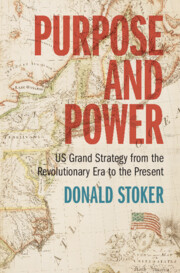Book contents
- Purpose and Power
- Purpose and Power
- Copyright page
- Dedication
- Contents
- Figures
- Maps
- Abbreviations
- Thinking about Grand Strategy in Peace and War
- Part I From Backwater to Great Power
- Part II From Great Power to Superpower
- 7 Stepping upon the Global Stage, 1913–1921
- 8 The Interwar Interlude, 1921–1939
- 9 Moving Astride the World: The Second World War, 1939–1945
- 10 The Hot Peace and the Korean War, 1945–1953
- 11 The Hot Peace: The Eisenhower, Kennedy, And Johnson Years, 1953–1969
- 12 The Vietnam War, 1961–1969
- 13 Détente and Defeat: Nixon, Ford, and Vietnam, 1969–1977
- 14 For Want of a Vision: The Carter Years, 1977–1981
- 15 Winning the Hot Peace: Reagan’s Great-Power Competition, 1981–1990
- Part III The Post–Cold War World
- Part IV Retreat and Defeat
- Acknowledgements
- Notes
- Index
12 - The Vietnam War, 1961–1969
from Part II - From Great Power to Superpower
Published online by Cambridge University Press: 11 January 2024
- Purpose and Power
- Purpose and Power
- Copyright page
- Dedication
- Contents
- Figures
- Maps
- Abbreviations
- Thinking about Grand Strategy in Peace and War
- Part I From Backwater to Great Power
- Part II From Great Power to Superpower
- 7 Stepping upon the Global Stage, 1913–1921
- 8 The Interwar Interlude, 1921–1939
- 9 Moving Astride the World: The Second World War, 1939–1945
- 10 The Hot Peace and the Korean War, 1945–1953
- 11 The Hot Peace: The Eisenhower, Kennedy, And Johnson Years, 1953–1969
- 12 The Vietnam War, 1961–1969
- 13 Détente and Defeat: Nixon, Ford, and Vietnam, 1969–1977
- 14 For Want of a Vision: The Carter Years, 1977–1981
- 15 Winning the Hot Peace: Reagan’s Great-Power Competition, 1981–1990
- Part III The Post–Cold War World
- Part IV Retreat and Defeat
- Acknowledgements
- Notes
- Index
Summary
Lyndon Johnson (LBJ) escalated American involvement in the Vietnam War. He used the Tonkin Gulf incident to secure the Tonkin Gulf Resolution, which gave him the leeway to intervene as he saw fit. The administration sought to coerce the North into a settlement guaranteeing South Vietnam’s independence. It launched first the ROLLONG THUNDER bombing campaign, which failed to achieve its aims. Meanwhile, the US increased its ground forces under William Westmoreland. He pursued a strategy built upon attrition of North Vietnamese forces, pacification of areas threatened by the Viet Cong insurgents, and training of the ARVN, the Army of the Republic of South Vietnam. The North enjoyed sanctuary in Cambodia and Laos and benefitted from the Ho Chi Minh trail running through Laos to move men and material into South Vietnam. Westmoreland launched “search and destroy” operations and relied on an inaccurate “body count” of enemy dead to measure the effectiveness of his strategy, which was shown to have failed when the North launched its 1968 Tet Offensive. Johnson refused to run for reelection, and Westmoreland was replaced.
Keywords
- Type
- Chapter
- Information
- Purpose and PowerUS Grand Strategy from the Revolutionary Era to the Present, pp. 416 - 445Publisher: Cambridge University PressPrint publication year: 2024

